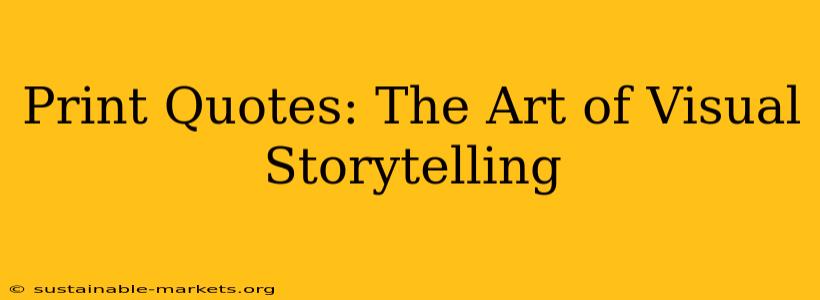Print quotes aren't just words on a page; they're powerful visual elements capable of capturing attention, conveying emotion, and telling a compelling story. In a world saturated with digital content, the strategic use of print quotes can elevate your design, strengthen your message, and leave a lasting impression. This guide explores the art of using print quotes effectively, transforming them from simple text into memorable visual narratives.
What Makes a Print Quote Visually Appealing?
A striking print quote is more than just a clever saying; it's a carefully crafted design element. Several factors contribute to its visual appeal:
-
Typography: The font choice is crucial. Serif fonts often lend a classic, sophisticated feel, while sans-serif fonts offer a modern, clean aesthetic. Consider the quote's tone and the overall design when selecting a typeface. Experiment with different weights, sizes, and kerning (the space between letters) to achieve optimal visual impact.
-
Color Palette: The colors surrounding the quote should complement its message and the overall design. A bold, contrasting color can make the quote pop, while a subtle, muted palette can create a more sophisticated and understated effect. Think about the emotions you want to evoke and choose colors accordingly.
-
Layout and Placement: How the quote is positioned on the page is just as important as the quote itself. Consider using white space effectively to draw attention to the quote. Experiment with different layouts, such as placing the quote in a box, using a unique shape, or integrating it with an image.
-
Imagery: Pairing a quote with a relevant image can amplify its message and create a more powerful visual narrative. The image should complement the quote's tone and enhance its meaning, not distract from it.
How to Design Effective Print Quotes
Creating a visually impactful print quote requires careful planning and execution. Here's a step-by-step guide:
-
Choose the Right Quote: Select a quote that resonates with your audience and aligns with your brand's message. A powerful quote can convey complex ideas concisely and memorably.
-
Select Your Typography: Experiment with different fonts to find the perfect match for your quote and design. Consider the font's readability and its ability to convey the quote's tone.
-
Determine Your Color Scheme: Choose colors that complement the quote and the overall design. Consider using a color wheel to find harmonious color combinations.
-
Plan Your Layout: Decide where the quote will be placed on the page and how it will be integrated with other design elements. Use white space effectively to draw attention to the quote.
-
Add Imagery (if applicable): If using imagery, select an image that complements the quote's message and enhances its visual impact. Ensure the image doesn't overpower the quote.
-
Refine and Iterate: Once you've created a draft, review it critically. Make adjustments to the typography, color scheme, and layout until you're satisfied with the final result.
Common Mistakes to Avoid When Designing Print Quotes
-
Using illegible fonts: Choose fonts that are easy to read and visually appealing.
-
Overusing embellishments: Keep the design clean and uncluttered. Too many embellishments can distract from the quote itself.
-
Ignoring white space: White space is crucial for creating visual hierarchy and drawing attention to the quote.
-
Poor color choices: Use colors that complement the quote and the overall design, avoiding jarring or clashing combinations.
-
Ignoring context: Ensure the quote is relevant to the overall message and target audience.
What are the best fonts for print quotes?
The best font for a print quote depends heavily on the context and desired mood. However, some popular and versatile choices include:
- Classic and Elegant: Garamond, Times New Roman, Didot
- Modern and Clean: Helvetica, Arial, Open Sans
- Playful and Unique: Playfair Display, Lobster, Pacifico
Remember, the choice of font should always support the overall message and aesthetic of your design.
How can I make my print quotes more visually appealing?
Beyond typography and color, consider these techniques to elevate your print quotes:
-
Use of texture: Add subtle texture to the background to provide depth and interest.
-
Creative framing: Use shapes or lines to frame the quote and draw attention to it.
-
Hand-lettering: Hand-lettered quotes can add a unique, personal touch.
-
Combining with other design elements: Integrate the quote with other visual elements like icons or illustrations to enhance its meaning.
By mastering these techniques, you can transform simple print quotes into captivating visual narratives that resonate with your audience and elevate your design work to new heights.

